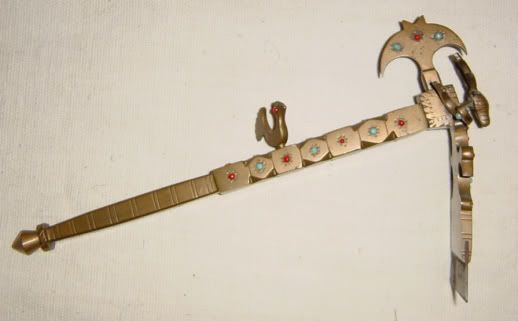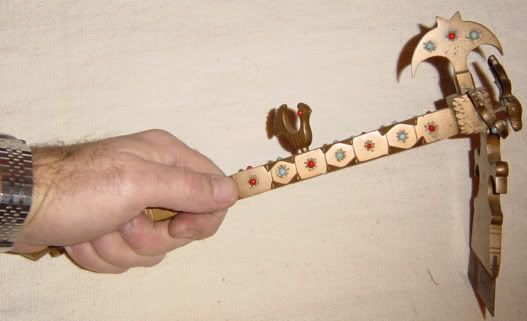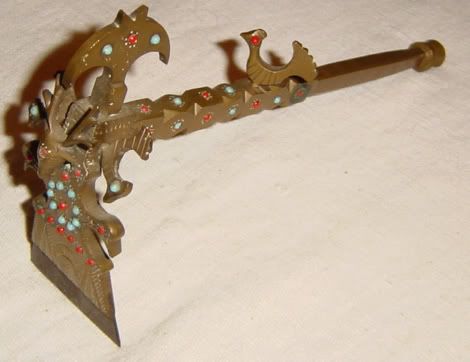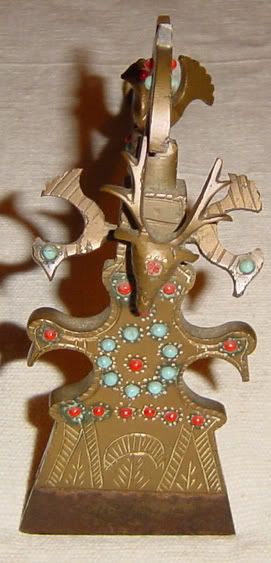
 |
|
|
#31 |
|
Member
Join Date: Dec 2004
Location: What is still UK
Posts: 5,739
|
I have finally located this sugar hammer. It had been tidied away by my wife, one of the things she calls ornaments
 you can take a horse to water you can take a horse to water  . Anyway as you can see it is jolly impressive and of the same size as the folding lohar. I feel sure that the lohar, small or large is a domestic tool, made to impress at social gatherings and other communal festivities. Sugar and other consumables did and probably still now not come in the easy packaged form we are used to. Sugar breaking apparatus were common in large houses in the west untill the late 19th century. The question is if you have a lohar, how do you feel? Have you paid too much because it is not a weapon or did you really get a bargin for a very nice piece of ethnographic art? . Anyway as you can see it is jolly impressive and of the same size as the folding lohar. I feel sure that the lohar, small or large is a domestic tool, made to impress at social gatherings and other communal festivities. Sugar and other consumables did and probably still now not come in the easy packaged form we are used to. Sugar breaking apparatus were common in large houses in the west untill the late 19th century. The question is if you have a lohar, how do you feel? Have you paid too much because it is not a weapon or did you really get a bargin for a very nice piece of ethnographic art?     
|
|
|

|
|
|
#32 | |
|
Member
Join Date: Dec 2004
Location: Houston, TX, USA
Posts: 1,254
|
Quote:
The ice/candy pick seems realistic, and I don't know that in preindustrial environments ice and candy would be considered a domain of children. As for an icepick as a weapon; that's pretty much all they're currently known as in N America. |
|
|
|

|
|
|
#33 |
|
Member
Join Date: Dec 2006
Location: Idaho, USA
Posts: 225
|
Hello- My first post. I have several lohars and don't believe the ice/candy pick explanation. The folding ones would not hold up to tough use and were folded for concealment. I was told by an Afghani that the lohar was originally intended to cut the reins of horses, camels, or donkeys. This explanation has always made sense to me.
|
|
|

|
|
|
#34 |
|
Member
Join Date: Dec 2004
Location: What is still UK
Posts: 5,739
|
A tool need not be very heavy to chip pieces of sugar off a big lump for sweet tea at gatherings. Why would you want to cut reins? they might be relatively expensive. Also a risky move if fighting when your adversary may be slashing around with a saber. Just a few thoughts.
|
|
|

|
|
|
#35 | |
|
Member
Join Date: Dec 2006
Location: Idaho, USA
Posts: 225
|
Quote:
A man on foot would cut the reins to disable the "power steering" on a mounted warrior and would not be worried about the expense to the rider. Also it would not be so risky a move if there was more than one man on foot. A lohar would be an extremely efficient weapon for grabbing the reins and cutting them without hurting the animal which would have been much more valuable than the reins. The lohars in my collection do not look like your sugar hammer in post # 31. I have used a hunting knife to open a can, but that doesn't make it a can opener. |
|
|
|

|
|
|
#36 |
|
Member
Join Date: Dec 2004
Location: What is still UK
Posts: 5,739
|
That sounds very logical. But it sounds as wrong to me as a sugar hammer/pick/tool does to you. A horseman would surely be able to control a horse without reins? what if the horse was moving quite quickly? Anyway what ever they are, they can be very attractive artifacts. With Radu's information and yours, that makes two differing native opinions
|
|
|

|
|
|
#37 |
|
Member
Join Date: Jan 2006
Location: Kent
Posts: 2,653
|
Perhaps if these were used against horsemen, cutting the girth straps would be more effective.......but very difficult. With the girth straps cut the saddle ( and rider) would 'slip off' ...
Unfortunately.....if you were a horse on a battle field.....you would be a prime target. Logistically, it would be greatly beneficial to 'take out' the 'mounted ' enemy to nullify any advantage that it gave your opponent. Horses would be met with 'lethal intent'. There is the possibility that the Lohar could be used to 'ham string' a horse, rider or foot soldier. Ham stringing....effectively a cut to the back of the leg..which severs the tendons......immobilises the victim. Armour or other forms of protection were not commonly used for the back of the legs and therefore were vulnerable. A 'ham strung' victim.....no longer able to fight would either bleed to death or would receive the lethal blow later. One other thing that has just struck me......some Lohar have 'fold away' blades.....that suggests to me that they were carried. A utility knife in the home is 'one piece'......the 'folder' type knife is designed to be transported. Would you need to carry a 'sugar axe' to your local cafe.... 
Last edited by katana; 29th December 2006 at 12:28 PM. |
|
|

|
|
|
#38 |
|
Member
Join Date: Jan 2006
Location: Kent
Posts: 2,653
|
What are the usual dimensions of a Lohar?......because this certainly looks like one....this is a part of a photo posted by DhaDha after a visit to Jodhpur, India. If the Lohar is a smaller version....perhaps it evolved into a secondary weapon....possibly used as a main gauche you could parry or hook your opponent's sword.
http://www.vikingsword.com/vb/showthread.php?t=3756 |
|
|

|
|
|
#39 |
|
Arms Historian
Join Date: Dec 2004
Location: Route 66
Posts: 9,738
|
This has been an intriguing thread, and it is always interesting to try to imagine exactly how many of these unusual weapons were used.It seems the lohar tends to be dismissed as a serviceable weapon due to the typically small size.
Many edged weapons such when actually seen seem relatively small, but in the skilled hands of a warrior were of course very deadly.As I had mentioned in discussion of the lohar at another time, in Afghan regions which were in British control in the 19th c. it was common for weapons to be concealed among tribesmen , and weapons such as the lohar in small size, or with folding handles would seem likely. While the suggestions for cutting reins or hamstringing etc. seem plausible in degree it does not seem that such a specialized weapon would be necessary for such opportunities in the heat of combat. The discovery of these items being used for 'candy cutters'or 'ice picks' does not seem unusual in present day or recent application, as novelty items are often fashioned recalling such weapons. I have seen many letter openers fashioned from interpretations of daggers and swords, and to see a traditional weapon used in local regions as a practical utility item seems perfectly understandable. It would seem to me that hafted weapons such as the zaghnal and others that may have associations to early dagger axes from China may well have influenced such a weapon form in regions in Afghanistan such as the lohar. The itinerant blacksmiths from Indian regions to the south that were known as the Lohar may well have fashioned early examples of these hafted weapons recalling such weapons, possibly in larger size. As always, it would be interesting to find earlier examples of 'lohar' to see if that may be the case. Best regards, Jim |
|
|

|
 |
|
|